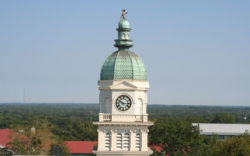Earlier this fall, as the updated North Oconee Greenway Concept Map was making its way to the Mayor and Commission, Flagpole reporter John Huie wrote two stories abusing River Oaks residents for panicky whining that, he said, threatened to “derail” the whole project. Maybe because it didn’t fit his “whining-residents-threaten-Greenway” narrative, Huie didn’t report that at its Nov. 4 meeting, for reasons having nothing to do with River Oaks, the commission voted 10 to zip to reject the entire map, sending it back to staff for a do-over.
It’s anybody’s guess whether we’ll take it, but the commission’s action gives us an opportunity for a thoughtful consideration of some large policy issues that were only obliquely hinted at in the agenda reports that accompanied the map to the commission.
Before I get to that, though, I need to clean up some brush that Huie left behind. Fixated on River Oaks, he didn’t report that University Heights residents also registered their opposition to what the Greenway planners had in store for them. In both cases, what residents were offered wasn’t, as Huie suggested, restful, tree-shaded lanes “near” their back yards, but destructive 10-foot-wide expanses of concrete and stone retaining walls draped across their front yards.
Having been sent to their rooms, the Greenway planners can think about three things that may get them a warmer reception when they come out.
First, somewhere, sometime, somebody decided that “connectivity” is a “broad community goal” central to our entire Greenway project. But you’d never guess that it’s a broad community goal from the dead-end streets all over Athens. They’re everywhere and make it totally predictable that superimposing a trail network dedicated to connectivity on our streetscape will sometimes be a square-peg-in-a-round-hole proposition.
The existing Greenway didn’t bring that home, because it largely avoided single-family neighborhoods, which is where most of our ubiquitous dead-end streets are. According to the Planning Commission’s most famous member, the only single-family homes affected were three or four uninhabitable structures in the flood plain, demolished after the government struck a mutually satisfactory deal with owners.
In contrast to that, the rejected map proposed trail segments in three single-family neighborhoods that together are home to over three hundred households. That’s not just some minor wrinkle in an otherwise familiar project, but an unprecedented departure from past practice. So, before we see another map, we should be asking whether we want to go there, rather than confine future Greenway development to the sort of high density commercial and multi-family areas it serves now.
Second, while I have no idea whether this would have made any difference in River Oaks and University Heights, updating our design standards could make the Greenway more palatable to residents of some single-family neighborhoods. For example, Greenville, SC, committed in 2007 to a 128-mile citywide trail network, consisting of what they call Greenway Trails, Street-Based Trails and Natural Surface Trails, the first and third being about what you would think. But their Street-Based Trails are just “bike-friendly roadways” with ordinary sidewalks. To make them “bike-friendly,” they use “sharrows,” the pavement markings all over Athens indicating to motorists that both cyclists and vehicles have the use of the entire traffic lane.
Our now-retired map proposed a “high-priority” trail segment that’s a perfect candidate for the Greenville treatment. Annes Court runs from South Milledge across from East Campus Road, doglegging to Gran Ellen Drive. At the dogleg, there’s an unused public right of way leading straight into Memorial Park, and the concept map proposed a trail segment along Annes Court from South Milledge into Memorial Park.
If I lived on Annes Court, I’d be pretty excited about having handy access to Memorial Park, but not at the cost of a 10-foot wide swath of concrete across my front yard. I’m guessing that sharrowing the street and improving the public right of way into the park would be a big hit on Annes Court. But our current design standards don’t provide for that. Coming up with design standards more adaptable to a wider variety of situations seems like a good use of the Greenway planners’ time.
Finally, about this connectivity thing in general, I get the appeal of being able to bike from Sandy Creek all the way to Whitehall on the Greenway. But connectivity isn’t a law of nature or even of greenways. Knoxville, TN, has 86 miles of greenway featuring very little connectivity outside the central business district along the Tennessee River. The network’s shortest segment is a mere two-tenths of a mile long and connects to nothing outside the park it’s located in.
While we may not want to give up on connectivity, neither should we make a fetish of it by trying to connect areas just because we can. That’s the impulse that seems to have repeatedly drawn planners to River Oaks and University Heights. Better they should take seriously Greenway Commissioner Elizabeth Little’s observation to Huie that, “It can sidetrack the whole greenway if you don’t listen to people’s concerns.”
Like what you just read? Support Flagpole by making a donation today. Every dollar you give helps fund our ongoing mission to provide Athens with quality, independent journalism.








Get the Greenway Off My Lawn
Earlier this fall, as the updated North Oconee Greenway Concept Map was making its way to the Mayor and Commission, Flagpole reporter John Huie wrote two stories abusing River Oaks residents for panicky whining that, he said, threatened to “derail” the whole project. Maybe because it didn’t fit his “whining-residents-threaten-Greenway” narrative, Huie didn’t report that at its Nov. 4 meeting, for reasons having nothing to do with River Oaks, the commission voted 10 to zip to reject the entire map, sending it back to staff for a do-over.
It’s anybody’s guess whether we’ll take it, but the commission’s action gives us an opportunity for a thoughtful consideration of some large policy issues that were only obliquely hinted at in the agenda reports that accompanied the map to the commission.
Before I get to that, though, I need to clean up some brush that Huie left behind. Fixated on River Oaks, he didn’t report that University Heights residents also registered their opposition to what the Greenway planners had in store for them. In both cases, what residents were offered wasn’t, as Huie suggested, restful, tree-shaded lanes “near” their back yards, but destructive 10-foot-wide expanses of concrete and stone retaining walls draped across their front yards.
Having been sent to their rooms, the Greenway planners can think about three things that may get them a warmer reception when they come out.
First, somewhere, sometime, somebody decided that “connectivity” is a “broad community goal” central to our entire Greenway project. But you’d never guess that it’s a broad community goal from the dead-end streets all over Athens. They’re everywhere and make it totally predictable that superimposing a trail network dedicated to connectivity on our streetscape will sometimes be a square-peg-in-a-round-hole proposition.
The existing Greenway didn’t bring that home, because it largely avoided single-family neighborhoods, which is where most of our ubiquitous dead-end streets are. According to the Planning Commission’s most famous member, the only single-family homes affected were three or four uninhabitable structures in the flood plain, demolished after the government struck a mutually satisfactory deal with owners.
In contrast to that, the rejected map proposed trail segments in three single-family neighborhoods that together are home to over three hundred households. That’s not just some minor wrinkle in an otherwise familiar project, but an unprecedented departure from past practice. So, before we see another map, we should be asking whether we want to go there, rather than confine future Greenway development to the sort of high density commercial and multi-family areas it serves now.
Second, while I have no idea whether this would have made any difference in River Oaks and University Heights, updating our design standards could make the Greenway more palatable to residents of some single-family neighborhoods. For example, Greenville, SC, committed in 2007 to a 128-mile citywide trail network, consisting of what they call Greenway Trails, Street-Based Trails and Natural Surface Trails, the first and third being about what you would think. But their Street-Based Trails are just “bike-friendly roadways” with ordinary sidewalks. To make them “bike-friendly,” they use “sharrows,” the pavement markings all over Athens indicating to motorists that both cyclists and vehicles have the use of the entire traffic lane.
Our now-retired map proposed a “high-priority” trail segment that’s a perfect candidate for the Greenville treatment. Annes Court runs from South Milledge across from East Campus Road, doglegging to Gran Ellen Drive. At the dogleg, there’s an unused public right of way leading straight into Memorial Park, and the concept map proposed a trail segment along Annes Court from South Milledge into Memorial Park.
If I lived on Annes Court, I’d be pretty excited about having handy access to Memorial Park, but not at the cost of a 10-foot wide swath of concrete across my front yard. I’m guessing that sharrowing the street and improving the public right of way into the park would be a big hit on Annes Court. But our current design standards don’t provide for that. Coming up with design standards more adaptable to a wider variety of situations seems like a good use of the Greenway planners’ time.
Finally, about this connectivity thing in general, I get the appeal of being able to bike from Sandy Creek all the way to Whitehall on the Greenway. But connectivity isn’t a law of nature or even of greenways. Knoxville, TN, has 86 miles of greenway featuring very little connectivity outside the central business district along the Tennessee River. The network’s shortest segment is a mere two-tenths of a mile long and connects to nothing outside the park it’s located in.
While we may not want to give up on connectivity, neither should we make a fetish of it by trying to connect areas just because we can. That’s the impulse that seems to have repeatedly drawn planners to River Oaks and University Heights. Better they should take seriously Greenway Commissioner Elizabeth Little’s observation to Huie that, “It can sidetrack the whole greenway if you don’t listen to people’s concerns.”
Like what you just read? Support Flagpole by making a donation today. Every dollar you give helps fund our ongoing mission to provide Athens with quality, independent journalism.
Hear Tracks From Grand Vapids’ Upcoming Debut
Athenians Protest Ferguson Peacefully